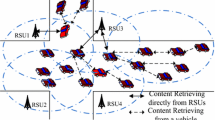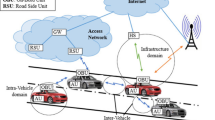Abstract
Recent advances in vehicular networks have enforced researchers to focus on various information dissemination techniques. Exchanging information among the vehicles is imperative due to the ever-changing network topology in vehicular networks. However, random transmitter selection in traditional CSMA based channel access mechanism limits the delay performance. Data, such as state information, is often time critical, and hence, efficient information dissemination techniques to improve delay performance are essential. In this work, we aim to minimize the average system age which is the mean number of time slots old a vehicle’s information is at all other vehicles in the network. To achieve this, we explore the benefits of simultaneous transmission along with piggybacking of information for multi-hop communication. While allowing simultaneous transmission guarantees faster dissemination of information, piggybacking facilitates dissemination of more information per transmission, thereby keeping the network more updated. We have also analysed the relationship between piggybacked information and number of vehicles in the network. Simulation results show improvement in network performance. Our analytical results are in good agreement with the simulation results.

























Similar content being viewed by others
References
Karagiannis, G., Altintas, O., Ekici, E., Heijenk, G., Jarupan, B., Lin, K., et al. (2011). Vehicular networking: A survey and tutorial on requirements, architectures, challenges, standards and solutions. IEEE Communications Surveys & Tutorials, 13(4), 584–616.
Hartenstein, H., & Laberteaux, K. P. (2008). A tutorial survey on vehicular ad hoc networks. IEEE Communications Magazine, 46(6), 164–171.
Li, F., & Wang, Y. (2007). Routing in vehicular ad hoc networks: A survey. IEEE Vehicular Technology Magazine, 2(2), 12–22.
Tonguz, O., Wisitpongphan, N., Bai, F., Mudalige, P., & Sadekar, V. (2007). Broadcasting in VANET. In Mobile networking for vehicular environments (pp. 7–12).
Panichpapiboon, S., & Pattara-Atikom, W. (2012). A review of information dissemination protocols for vehicular ad hoc networks. IEEE Communications Surveys & Tutorials, 14(3), 784–798.
Jiang, D., & Delgrossi, L. (2008). IEEE 802.11p: Towards an international standard for wireless access in vehicular environments. In IEEE vehicular technology conference (pp. 2036–2040).
Kaul, S. (2011). Propagation and delay-optimal safety messaging in vehicular network. Ph.D. Thesis, Rutgers University.
Kaul, S., Yates, R., & Gruteser, M. (2011). On piggybacking in vehicular networks. In IEEE global telecommunications conference (pp. 1–5).
Deng, J., Liang, B., & Varshney, P. K. (2004). Tuning the carrier sensing range of IEEE 802.11 MAC. In IEEE global telecommunications conference (Vol. 5, pp. 2987–2991).
McCanne, S., & Floyd S. Network simulator. Accessed 18 June 2015.
Hsieh, T.-Y., & Tseng, Y.-C. (2011). Vehicular traffic information dissemination for WAVE/DSRC networks. In Sixth international symposium on wireless and pervasive computing (pp. 1–6).
Farnoud, F., & Valaee, S. (2009). Reliable broadcast of safety messages in vehicular ad hoc networks. In IEEE INFOCOM (pp. 226–234).
Fallah, Y. P., Huang, C.-L., Sengupta, R., & Krishnan, H. (2011). Analysis of information dissemination in vehicular ad-hoc networks with application to cooperative vehicle safety systems. IEEE Transactions on Vehicular Technology, 60(1), 233–247.
Khabazian, M., Aissa, S., & Mehmet-Ali, M. (2011). Performance modeling of message dissemination in vehicular ad hoc networks with priority. IEEE Journal on Selected Areas in Communications, 29(1), 61–71.
Cenerario, N., Delot, T., & Ilarri, S. (2008). Dissemination of information in inter-vehicle ad hoc networks. In IEEE intelligent vehicles symposium (pp. 763–768).
Zhong, T., Xu, B., & Wolfson, O. (2008). Disseminating real-time traffic information in vehicular ad-hoc networks. In IEEE intelligent vehicles symposium (pp. 1056–1061).
Ros, F. J., Ruiz, P. M., & Stojmenovic, I. (2009). Reliable and efficient broadcasting in vehicular ad hoc networks. In Sixty nineth IEEE vehicular technology conference (pp. 1–5).
Torrent-Moreno, M., Santi, P., & Hartenstein, H. (2006). Distributed fair transmit power adjustment for vehicular ad hoc networks. In Third annual IEEE communications society on sensor and ad hoc communications and networks (Vol. 2, pp. 479–488).
Mittag, J., Schmidt-Eisenlohr, F., Killat, M., Härri, J., & Hartenstein, H. (2008). Analysis and design of effective and low-overhead transmission power control for VANETs. In Fifth ACM international workshop on vehicular inter-networking (pp. 39–48).
Mangharam, R., Rajkumar, R., Hamilton, M., Mudalige, P., & Bai, Fan (2007). Bounded-latency alerts in vehicular networks. In Mobile networking for vehicular environments (pp. 55–60).
Vinel, A. V., Dudin, A. N., Andreev, S. D., & Xia, F. (2010). Performance modeling methodology of emergency dissemination algorithms for vehicular ad-hoc networks. In Seventh international symposium on communication systems, networks & digital signal processing (pp. 397–400).
Yang, L., Guo, J., & Wu, Y. (2009). Piggyback cooperative repetition for reliable broadcasting of safety messages in VANETs. In Sixth IEEE consumer communications and networking conference (pp. 1–5).
Wu, Y., Yang, L., Wu, G., & Guo, J. (2009). An improved coded repetition scheme for safety messaging in VANETs. In Fifth international conference on wireless communications, networking and mobile computing (pp. 1–4).
Qing, X., Mak, T., Ko, J., & Sengupta, R. (2007). Medium access control protocol design for vehicle–vehicle safety messages. IEEE Transactions on Vehicular Technology, 56(2), 499–518.
Kaul, S., Gruteser, M., Rai, V., & Kenney, J. (2011). Minimizing age of information in vehicular networks. In Eighth annual IEEE communications society conference on sensor, mesh and ad hoc communications and networks (pp. 350–358).
Mittag, J., Thomas, F., Härri, J., & Hartenstein, H. (2009). A comparison of single and multi-hop beaconing in VANETs. In Sixth ACM international workshop on vehicular internetworking (pp. 69–78).
Abdrabou, A., & Zhuang, W. (2011). Probabilistic delay control and road side unit placement for vehicular ad hoc networks with disrupted connectivity. IEEE Journal on Selected Areas in Communications, 29(1), 129–139.
Ergen, S. C., & Pravin, V. (2010). TDMA scheduling algorithms for wireless sensor networks. Wireless Networks, 16(4), 985–997.
Shen, X., Cheng, X., Yang, L., Zhang, R., & Jiao, B. (2014). Data dissemination in VANETs: A scheduling approach. IEEE Transactions on Intelligent Transportation Systems, 15(5), 2213–2223.
Gramaglia, M., Trullols-Cruces, O., Naboulsi, D., Fiore, M., & Calderon, M. (2014). Vehicular networks on two Madrid highways. Technical report, HAL.
Daniel, K., Jakob, E., Michael, B., & Laura, B. (2012). Recent development and applications of SUMO—simulation of urban mobility. International Journal on Advances in Systems and Measurements, 5(3&4), 128–138.
Acknowledgements
The authors would like to thank Rahul Thakur and the anonymous reviewers for their valuable comments and suggestions. This work was supported by the Department of Science and Technology, New Delhi, India.
Author information
Authors and Affiliations
Corresponding author
Rights and permissions
About this article
Cite this article
Patra, M., Sengupta, A. & Murthy, C.S.R. On minimizing the system information age in vehicular ad-hoc networks via efficient scheduling and piggybacking. Wireless Netw 22, 1625–1639 (2016). https://doi.org/10.1007/s11276-015-1056-3
Published:
Issue Date:
DOI: https://doi.org/10.1007/s11276-015-1056-3




